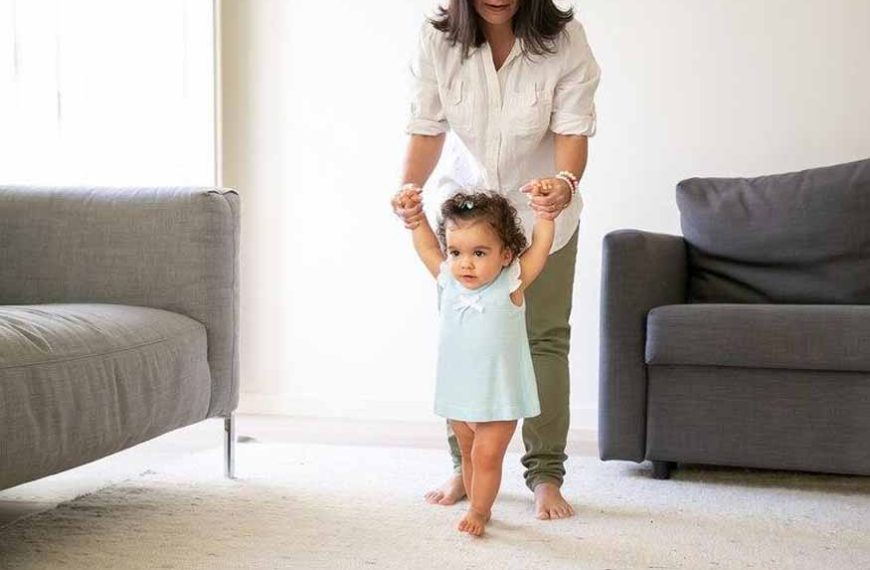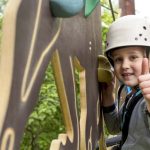The moment your baby takes their first independent step is one of the most thrilling milestones as it develops from a newborn to a toddler. For your child, walking offers up a whole new world of play, discovery, and independence. Even while every kid develops at their own rate, there are steps you can do to help your child gain confidence in walking independently. This comprehensive book covers everything from when to start walking with your baby to safety-proofing your house, methods and activities to practice and advice on how to support your newly mobile child.
When to Start:
Most babies take their first steps somewhere between 9-18 months. There is a wide range of what’s considered normal. Signs your baby may be ready to start walking practice include:
Good head control and ability to sit upright, unsupported They can get into sitting or standing positions on their own Pulls up onto furniture or other supports to stand Cruises (walks while holding onto furniture) Lowers themselves gently without falling Stands unsupported for at least 1-2 seconds Keep in mind that even if your baby can do these things, they may still not be ready or interested in walking yet. Follow your baby’s lead, and don’t pressure them.
Preparing Your Home
Before your baby takes off cruising or walking, it’s important to fully baby-proof any areas they will access. This includes:
Installing safety gates at the top/bottom of stairs and guards on windows Securing top-heavy furniture to the wall with straps or braces Keeping small objects, medications, cleaners, and chemicals out of reach Covering sharp edges of furniture with guards Keeping cords out of reach and securing loose rugs Installing cabinet locks and doorknob covers Practicing Standing Once your baby can sit steadily without support, you can begin working on standing. Good activities include:
- Holding baby’s hands while they balance standing, gradually use less support.
- Letting baby use your fingers or furniture for balance support
- Praising and cheering when they stand unaided, even for 1-2 seconds
- Having toys and objects for the baby to stand and reach for
- Do not leave the baby unattended when practicing standing. Stay close, spot them, and provide comfort if they get frustrated. Keep practice sessions brief, about 10 minutes at a time, allowing breaks.
Building Leg Strength:
Strong leg muscles are key for walking. Try exercises like:
- Bicycle legs:Gently move baby’s bent legs like pedaling
- Pat-a-cake:Clap baby’s feet together while they’re on their back
- Leg presses:Hold baby upright with feet touching a flat surface, let them push legs out
- Crawling:Gets muscles working once baby can hands-and-knees crawl.
- You can also strengthen muscles during daily care like diaper changes. Slowly move their legs into different positions: cross one ankle over the other, lift feet overhead. Any movement helps build strength!
First Steps Techniques:
When your baby pulls to stand and cruises with ease, they might be ready to try a few steps. Some proven techniques include:
- Gently hold both hands while the baby takes steps forward. Provide enough support so they don’t fall.
- Use an adult-sized belt tied loosely around the baby’s waist for them to hold onto as they walk. Walk behind, spotting them.
- Push/pull supportive toy “walkers” for them to walk short distances holding on. Limit use to flat surfaces only.
- Arrange sturdy furniture in a line for them to hold onto and “cruise” increasing distances.
- Provide lots of praise, smiles, and applause for attempts. Don’t expect perfection at first, wobbly steps or falls are normal. Keep sessions brief and quiet before frustration sets in.
Activities to Practice Walking:
As your baby’s skills improve, keep them motivated with fun activities. Great ideas include:
- Please take advantage of their natural desire to walk toward you. Back up and encourage them to walk over.
- Scatter bath or pool toys on the floor and encourage them to walk from one toy to the next.
- Go outside and teach them to walk on different surfaces like grass or sand
- Blow bubbles and let them walk after and pop them
- Play music with a lively beat for them to “dance” to on their feet
What to Expect Along the Way:
Your baby will likely master a few steps then seem to go backwards a bit by sitting and crawling. This regression is normal— they are getting stronger and balancing more before trying to walk again. Other things that might happen as they gain confidence:
- Preferring one leg over the other when standing/walking. This balance control comes with time.
- Difficulty coordinating arms and legs, resulting in falls or dropping toys
- Walking well but unable to stand up from sitting/squatting without assistance
- Taking first solo steps and then returning to crawling as primary mobility
- Not walking until 15-18 months or even older (still considered normal range)
There will be many ups and downs before your little one walks smoothly across a room! Stay positive through the process.
Supporting Your New Walker:
Once those first solo steps turn into frequent walking, there are things you can do to encourage safety:
- Childproof again as they gain access to more areas
- Get the proper shoes with thin, flexible soles for gripping
- Supervise closely around stairs— teach them to sit down backward on steps
- Hold their hand when walking on uneven surfaces
- Provide push/pull toys to help balance
- Consider getting a wearable safety device so they can’t wander too far
And most importantly— celebrate this huge achievement! Capture videos and photos because before you know it, your walking baby will be off exploring everything within reach at top speeds. Enjoy this special time helping your baby gain an exciting new independence.
Extended Practice for Confident Walkers:
Once your baby is confidently walking across rooms and between furniture, you can continue building their skills with regular practice. Extending walking practice helps improve stability, balance, coordination, and muscle development.
Try setting up fun little obstacle courses for your little one using household items like pillows to step over, tunnels to crawl through made from furniture and blankets, targets on the floor to step on, and balls to kick across the room. Just use your imagination! By making a game of it, your baby will gain agility while having a blast.
As the weather allows, bring practice outdoors. Local parks often have excellent playground equipment perfect for improving toddler walking abilities. Elements like balance beams, small slides, mini staircases, and gentle slopes give them practice with ramping up skills.
You can also set up your own outdoor course at home using features in your backyard or patio. Sidewalk chalk provides colorful targets, a small slide or ramp can easily be propped against outdoor furniture at an age-appropriate incline, and stepping stone pathways make for good balance practice.
The benefits of ongoing practice are tremendous. Confident walking leads to running, jumping, kicking, and eventually, much more advanced gross motor skills. And the longer they walk independently each day further boosts mobility, connection with the environment and self-assurance.
So get out there and keep encouraging your little one to tackle simple challenges on two feet! They’ll gain so much in the process.
For more such interesting blogs, Visit EuroKids.
















